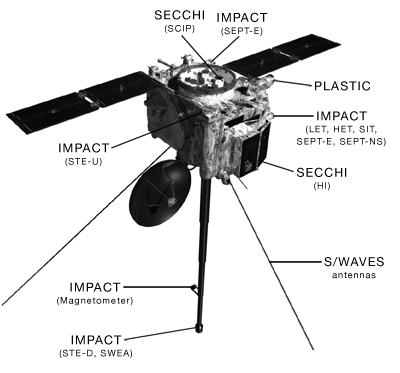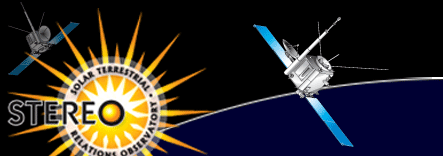STEREO (Solar TErrestrial RElations Observatory) is the third mission in NASA's Solar Terrestrial Probes program (STP). This two-year mission will employ two nearly identical space-based observatories - one ahead of Earth in its orbit, the other trailing behind - to provide the first-ever stereoscopic measurements to study the Sun and the nature of its coronal mass ejections, or CMEs.
- Understand the causes and mechanisms of coronal mass ejection (CME) initiation.
- Characterize the propagation of CMEs through the heliosphere.
- Discover the mechanisms and sites of energetic particle acceleration in the low corona and the interplanetary medium.
- Improve the determination of the structure of the ambient solar wind.
STEREO provides a unique and revolutionary views of the Sun-Earth system. The satellites trace the flow of energy and matter from the Sun to Earth as well as reveal the 3-D structure of coronal mass ejections and help us understand why they happen. STEREO also provides alerts for Earth-directed solar ejections, from its unique side-viewing perspective adding it to the fleet of Space Weather detection satellites.


STEREO High Energy Protons Ahead - 7 Day
If you find broken links or incorrect information, please contact us at webmaster@radiation-effects.com
STEREO High Energy Protons Behind - 7 Day
The two STEREO observatories are nearly identical with selective redundancy. The building of the spacecraft bus and the integration of the instruments were done by the Johns Hopkins University Applied Physics Laboratory (APL).
The two solar-powered observatories with 3-axis-stabilization, each had a mass at launch of approximately 1,364 pounds (620 kilograms, including propellant). The spacecraft communicate with the APL-based Mission Operations Center via NASA’s Deep Space Network.
The significant challenge in spacecraft design is the large number and extent of the instrument fields-of-view, coupled with the various instruments’ competing design requirements to ensure successful science observations.
The major design drivers to support the science instrument performance are a conductive outer surface for the energetic particle experiments, stringent electromagnetic compatibility and interference requirements for the radio burst tracker, and contamination control of both volatiles and particulates for the imager experiment.
The spacecraft bus consists of six operational subsystems supporting two instruments and two instrument suites. This combination provides a total of 16 instruments per observatory. The subsystems include: command and data handling; radio frequency communications; guidance and control; propulsion; power; and thermal.


